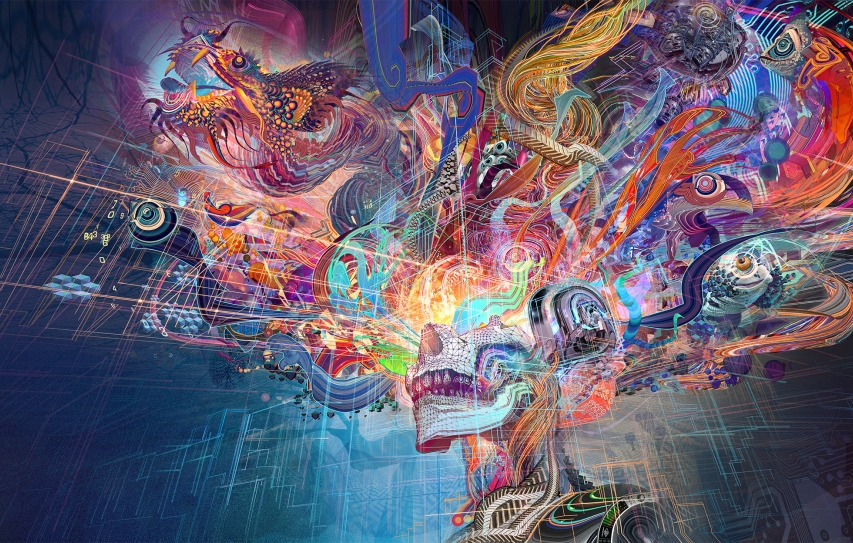
Techno-Visionaries And The Philosopher’s Stone
by Shiv Bhalla June 10 2015, 12:59 pm Estimated Reading Time: 4 mins, 22 secs“I think that novels that leave out technology misrepresent life as badly as Victorians misrepresented life by leaving out sex.”
– Kurt Vonnegut
It was in the frames of Stanley Kubrik’s visionary science fiction film ‘2001 A Space Odyssey’ that he lunged into the future, foreshadowing the technological leaps to come in the twenty first century. In Kubrick’s rapturous, high concept, pure cinematic rendition depicting humanity transcending the threshold of its own desolation in space to explore its vastness and glory; it is not the depiction of technologies such as interactive interfaces that resemble ipads, nor the sentient and emotional computer HAL 9000 that is striking. It is rather the spiral of human evolution and the ability to manifest what we envision that really sums up our relationship with technology. It is vision that captures our imaginations that ignites the chain reaction domino fall that ultimately leads to the realization the vision; which in an evolutionary timeframe is no more than the blink of an eye. It is this spirit, this unwavering dedication to imagination that guides our species to evolve, to bend and shatter our horizons, to split the membrane revealing new truths, new existences, novel possibilities.
“Any sufficiently advanced technology is equivalent to magic”.
– Arthur C. Clarke
Our technology is essentially an extension of our human phenotype, a subset of our species just as anthills connected by intricate, byzantine conduits are a subset of the ant species. Technology is neither inherently good nor evil, it is tool to amplify and individual and his abilities. Delving back into Kubrick’s stellar magnum opus, the first part entitled “The Dawn of Man” it is the ape- humanoid hybrid’s discovery of tools that eventually gives rise to the telescopic development of more abstract tools such as language. But prior to language the bone in ‘2001’ was used by the humanoid- ape as an inflictor of violence. It took evolution for tools to be used as a constructive means. The tool is essentially an extension of man. That is probably why most science fiction plots revolve around a dystopian technocratic future of either oppressive totalitarian rule by technological domination; or humanity overwhelmed by a race of cyborgs or sentient robots. Because H.G Wells, Isaac Asimov, Arthur. C. Clarke and other great science fiction authors chose to project humanity’s dark side onto the technology they wrote about. It was William Gibson who imagined a more ideal future with technology, in many ways capturing the stupefying awe that we feel about the transcendent nature of technology today.
“The art challenges the technology, and the technology inspires the art”.
– John Lasseter
What is interesting is the cumulative imagination of these various art forms ignited a vision in our cultural consciousness that came into manifestation decades later. Our imaginations have spilled over into reality in a negligible amount of time. We are in fact cyborgs today, our smart phones are literally a bionic brain: giving us access to information in a fraction of a moment. We have in the palms of our hands better connectivity than the most powerful man in the world had twenty five years ago. A pacemaker is literally a robotic heart for sufferers of heart disease.The poetic abstractions from the dreams of artists have been condensed into tiny devices that baffle and awe. Kevin Kelly, the executive editor of Wired magazine said ““Technology is stitching together all the minds of the living, wrapping the planet in a vibrating cloak of electronic nerves, How can this not stir that organ in us that is sensitive to something larger than ourselves?”. As human ability and potential piles on itself, so does that of technology and they share the ecstatic dance of mutual evolution.
“Humanity is acquiring all the right technology for all the wrong reasons”.
– R. Buckminster Fuller
In the finalpart of Kubrick’s space odyssey, Dr. Bowman is depicted transcending humanity by finding the final monolith. He is then devoured by the stargate after which he is subjected to a beautifully crafted acceleration to his death where he is reborn as a starchild, a metaphor for having transcended humanity. Amongst the various intriguing interpretations of the film, one particular meta commentary stands out. Dr. Bowman was beyond the existential conflict of HAL 9000, a computer that was incapable of error. It is interesting to note that Kubrick is referring to the idea that man must eventually evolve beyond his own technology to break through to the final frontier, the singularity, the philosopher’s stone. With unparalleled exponential development in technology, society today is static if not plunging into entropy. It is the resolution of this conflict that will catapult humanity into the future and ultimately masters the great beyond. We must match if not outdo the breakneck pace of technological revolution, or else technology will leave us behind. Technology is simply a tool, it is how we interact with it that will determine whether the future will be utopia or dystopia.
“It has become appallingly obvious that our technology has exceeded our humanity.”
– Albert Einstein




-173X130.jpg)
-173X130.jpg)
-173X130.jpg)
-173X130.jpg)
-173X130.jpg)
-173X130.jpg)

-173X130.jpg)